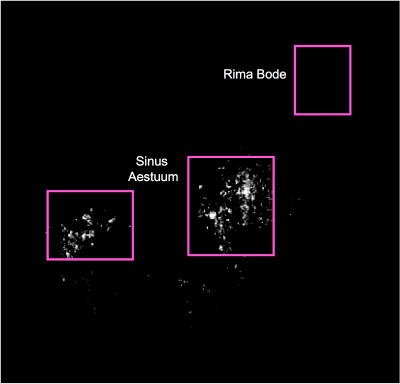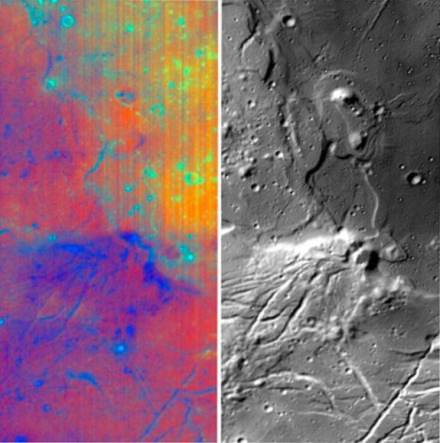[/caption]
Scientists analyzing data from the Moon Mineralogy Mapper instrument or M Cubed, on the Chandrayann-1 spacecraft found two different kinds of never-before-seen lunar rocks – one hidden in a basin on the far side of the Moon and the other staring right at us on the near side. Just four minerals — plagioclase feldspar, pyroxene, olivine, and ilmenite — account for 98-99% of the crystalline material of the lunar crust, but the composition of these newly found rocks are two different kinds of spinels, a magnesium spinel and a chromite spinel. The composition and location of these new rock types are extremely puzzling, and lunar scientists are trying to determine more details about these mysterious Moon rocks.
Universe Today talked with Dr. Carle Pieters from Brown University who is the Principal Investigator for M Cubed as well as Dr. Jessica Sunshine from the University of Maryland, a co- investigator with the project.
Universe Today: Dr. Pieters, tell us about the newly found rocks on the far side.
Dr. Carle Pieters: The rock type on the far side of the Moon that is so unusual is a magnesium spinel, which typically has iron, magnesium, and aluminum oxide. In looking in detail at the spectral properties of the Moscoviense Basin on the far side — and in particular the material along the inner-most ring of this basin — we noticed there were a few little areas that were spectroscopically unusual. So, of course we investigated those in more detail. We saw three primary different compositions, and two we understand and had seen elsewhere, and they are rich in iron bearing minerals called pyroxene and olivine, and we saw small areas of these that are widely separated.
But then the third kind of mineral, the magnesium spinel, we had never seen before on the Moon, and what is interesting is not only is there an unusual abundance of this particular mineral, but it also has a lack of the pyroxenes and olivines that we see elsewhere. So there are several mysteries that are interwoven here. One, is why do we have a concentration of this spinel mineral and however it got concentrated in this area, why aren’t the other minerals that we are familiar with also there, because they are not.
So this is a big mystery and it is a very exciting one because now we have to reexamine our understanding of the character of the lunar crust, in particular to the depths that might have been tapped by this enormous basin and that we are now looking at as exposed on the surface.
Universe Today: So, what does this tell you about this region on the Moon?
Pieters: Not only are these unusual areas compositionally, and they are only about a kilometer or two in size, but in every method we’ve been able to look at thus far, in every wavelength and resolution, they have no other distinguishing properties. Typically, on the Moon to indentify an usual composition we look for a fresh crater that has excavated and exposed material on the surface of the Moon. These areas have no fresh craters, no disturbance at all across their surface, even at the highest resolution that is seen with the LROC (Lunar Reconnaissance Orbiter Camera) instrument which measures a half a meter resolution.
These are old surfaces that have been undisturbed but have an extremely unusual composition. And even the space weathering that has occurred on the surface throughout the billions of years of history on the Moon has not erased their unusual compositions. So, they are unusual for the kind of compositions we see, but they are also unusual because they have no identifying property that allows us to identify them in our imagery which is quite unusual for features on the surface of the Moon.

Universe Today: Now let’s move to the near side of the Moon, where Dr. Jessica Sunshine and her team went looking for unusual data.
Dr. Jessica Sunshine: One of the things I was asked to be in charge of was looking for anomalies, things that just didn’t look like the rest of the Moon. And of course you never know what’s going to happen under those circumstances. Carle had already discovered there seemed to be a magnesium spinel on the far side of the Moon and I went looking to see where else it could be. We found that the only place that we had anything that looked like the spinel mineral in the data we had was on the near side and it was an extremely large deposit in the middle of the central nearside, almost exactly dead center at zero-zero. And we started looking a little more carefully and realized that it wasn’t really the same kinds of things that Carle found, which truly was a new rock type on the far side of the Moon, but something really usual about the region.
We had already known the region was full of what we call dark mantle deposits or pyroclastic deposits, which is firefountaining deposits. This came from explosive eruptions of lava and gas over large areas of the Moon, about the size of Massachusetts. And we knew that three of them were there, it just turned out that one of them was compositionally different from the other ones, and in particular it had the kind of spinel which is a chromite, because it has chrome in it, and now we’re busy trying to figure out why this deposit is different from the one next door, and what does it mean. And we’re still working that process out as we speak.
Universe Today: What is it like to find something new like this on the side of the Moon that humans have been able to see for thousands of years?
Sunshine: Yes, I tend to title my talks on the subject something like, “Hidden in Plain Sight” because they are! It’s right there and I think this is a really fascinating part of this because we have been starring at the Moon, as humanity for millennia and if our eyes were slightly different we would see this one really dark spot in the middle of the Moon that is different from anywhere else.
Universe Today: What specifically about the Chandrayaan-1 spacecraft and the Mcubed instrument made these discoveries possible?
Sunshine: M Cubed collects data over a much broader range of light than our human eyes can. We can all see the rainbow, we’re all familiar with that, from blue to red, but there is light at shorter wavelengths, which we call ultraviolet, and particularly for this case, there is light at shorter wavelengths called infrared. M Cubed goes farther into the infrared than humans can see and it is there we are able to see diagnostic fingerprints of different kinds of minerals. So I suspect there are certain kinds of bugs who would look at the Moon and would have known these deposits are there because their vision goes into the infrared!
Universe Today: So, Dr. Pieters, does these new discoveries tell us there are still more mysteries to find on the Moon?
Pieters: Oh, absolutely! We’ve just barely scratched the surface here. This is thrilling from a spectroscapist’s point of view, of course, but also from someone who is trying to understand how planets work, and in particular how this wonderful small body in our neighborhood is telling us about the characteristics of crustal evolution and fundamental properties of planetary surfaces.
You can listen to a version of this interview on the 365 Days of Astronomy podcast and the NASA Lunar Science Institute podcasts


What is not very well explained in this article is what Spinel’s are.
http://en.wikipedia.org/wiki/Spinel
They are crystals like Ruby; although they come in many different colors.
Gemstones On the Moon.! Perhaps DeBeers might fund a mining operation. 🙂